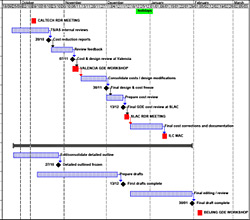Director's Corner
19 October 2006
 Barry Barish |
Road to the ILC Reference Design
The next big goal for the Global Design Effort is to produce an ILC Reference Design Report (RDR) that will include Preliminary Costing. We are systematically working toward this goal, and have now progressed far enough to set a realistic schedule. In recent columns, I highlighted some of the evolution of the baseline resulting from either technical advances from our R&D programme or from cost to performance optimisation. Several more studies are underway, and we expect to evaluate these in the coming weeks, especially at the upcoming Valencia GDE meeting in November. Following that meeting, we will make some final decisions for the RDR and begin the process of concluding this phase of the design effort. Our plan is to release the draft Reference Design Report and Preliminary Costing on the time scale of the GDE Meeting in Beijing in February 2007.
 The GDE Schedule to complete the Draft Reference Design Report and Preliminary Costing. |
The ILC baseline configuration (BCD) developed last year defined the major parameters and concepts for the ILC. This year, through an orderly change control process, we have evolved that design concept. The next big step is to create a reference design, in which we will define in detail the technical parameters and components that make up each of the subsystems in the ILC baseline. The main linac, for example, is made up of superconducting RF cavities, cryomodules that house the cavities, low level and high level RF, magnets and so on. For each of these sub-elements, we are determining the technical and performance parameters, and itemising the components in order to make a first estimate of the costs. This process will give us a complete design concept but with only a few engineering drawings. The RDR will provide guidance for our R&D programme, motivate industrial studies and be the basis for the engineering design needed to make a project proposal. For the RDR, we have deferred consideration of those potential changes that will require significant engineering or industrial studies to evaluate.
We have concentrated on possible optimisation without actual engineering designs, and this has already led to some significant changes, such as changing from 2 mrad x 20 mrad crossing angles to 14 mrad x 14 mrad. We are presently doing other such trade studies, many within subsystems and some that affect the overall design and performance. Those that involve physics performance are being studied with representatives of the physics community, even prior to potential change requests, and these will be the subject of discussions at our next GDE meeting in Valencia.
Our immediate goal is to finalise a reference design, in which we have already carried out optimisations of cost to performance possible in this pre-engineering phase. Further cost optimisation will occur during the engineering phase and many of those will be outlined in our RDR. At the GDE meeting in Valencia Spain 7-10 Nov, we will complete our cost reviews of the various technical systems, and we will hold special sessions on some changes under consideration that would affect physics performance. Final decisions needed to complete the Reference Design Report will be made at or soon after this meeting, and then we will assemble the RDR, review it internally at a special meeting at SLAC in December.
Next year, we will begin by presenting the RDR to the GDE Machine Advisory Committee (MAC) on 10-12 Jan and give preliminary briefings to funding agencies during the following weeks. The GDE will decide on the release of the draft RDR at our meeting in Beijing in February.
What happens then? We have proposed that an international review of the RDR be performed and that is being considered by the funding agencies. We hope to complete the review process by summer, revise and finalise the RDR and then begin in earnest on the next phase -- developing an engineering design.
-- Barry Barish